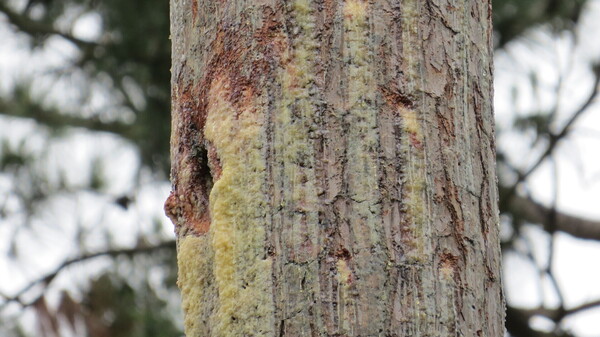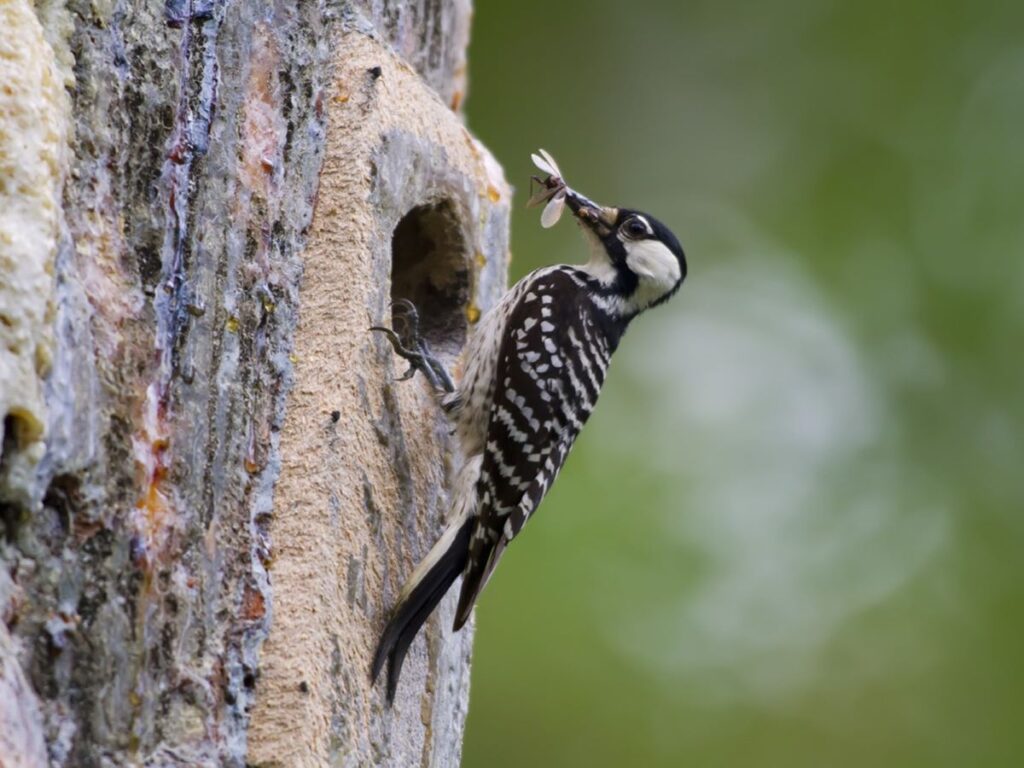Habitat for roosting and foraging
The red-cockaded woodpecker lives in open, mature pine forests across the southeastern U.S. It’s different from other woodpeckers in that it makes its cavities for roosting and nesting in live pine trees. Most other woodpeckers construct their cavities in dead trees.
The older pines preferred by the RCW are often infected with a fungus called red heart. This fungus softens the wood in the center of the tree, making it easier for the RCW to excavate its cavity. Red-cockaded woodpeckers in East Texas can reside in pines forests with loblolly, shortleaf, longleaf, or slash pines.
RCW cavity trees are characterized by a round cavity entrance about two inches in diameter and numerous “resin wells” that ooze sap. Resin flowing down the face of an RCW cavity tree from the wells and entrance hole gives the appearance of a melting candle. This resin barrier helps to protect the nest from the RCW’s major predator, the rat snake.
The bark of active RCW cavity trees may also have a reddish appearance on part of the trunk from the RCW flaking off layers of the bark. Abandoned RCW trees would have dry, gray resin and the bark of the tree and resin wells would be its normal gray-brown color. The cavity entrance may be enlarged by other woodpecker species.
RCWs require adequate foraging, or food gathering, habitat. Their diet consists mostly of insects, spiders, centipedes, and other animals found on, under, and in the bark of trees. They’re also known to eat small berries and seeds.
Good foraging habitat consists of large stands with pine trees 10 inches in diameter and larger. RCWs will occasionally forage on hardwoods as well. A good herbaceous groundcover of grasses and forbs is important for insect production. The stand needs to have an open, park-like character. Foraging stands should have little hardwood and pine midstory and few overstory hardwoods.

RCW cavity on pine tree.
Family life
Red-cockaded woodpeckers do not migrate. They live in family groups, ideally consisting of a mated pair and one or more helpers. Helper birds are usually male offspring of previous breeding seasons.
There is only one breeding pair per group. All members of the group help build cavities, defend the group’s territory, incubate eggs, and feed the young.
Nesting season is March through July with egg laying generally occurring in April, May, and sometimes June. The female lays her eggs in the breeding male’s roost tree. Then eggs hatch in 10 to 12 days. After hatching, the nestlings remain in the cavity for about 26 days. When the young birds leave the nest, they stay with the group for a few months. Later, the young juveniles may disperse to other areas. A male may remain with the group to become a helper.
Harvesting of timber is compatible with RCW management. As long as basic habitat requirements are met and maintained, timber can be harvested in areas with red-cockaded woodpeckers except during nesting season. Methods that favor leaving enough of the larger, older pines as well as planning for an on-going supply of older pine trees are acceptable.
Distribution
Most RCWs in Texas occur on National Forest lands. They are also on State lands, investment company lands, and non-industrial private lands. All four of the National Forests in Texas have red-cockaded woodpeckers that can be viewed by the public. The W. G. Jones State Forest south of Conroe and the I. D. Fairchild State Forest between Rusk and Palestine also have RCWs.
RCWs are known to occur in: Angelina, Cherokee, Houston, Jasper, Montgomery, Newton, Polk, Sabine, San Augustine, San Jacinto, Trinity, Tyler, and Walker counties.
Management
There are some large-acreage forest landowners who do have RCWs on their property. However, it is rare. U.S. Fish and Wildlife service has provided private lands guidelines for managing RCWs, but, unless you already have them on your property or live near a family group of RCWs and want to possibly attract them to your property, there is no need to worry about having to do intensive management for this bird.
Learn more about management methods for red-cockaded woodpeckers in our management guidelines for the red-cockaded woodpecker.
Safe Harbor Program
Since a majority of property in East Texas is privately owned, these lands can play an important part in the continued recovery of this special bird. If you own pine timber in East Texas, and especially if the property is near one of our national forests, you may be interested in the voluntary Safe Harbor program.
